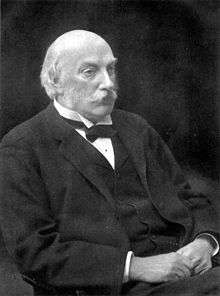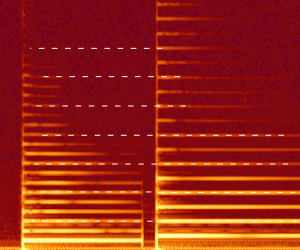John William Strutt, 3rd Baron Rayleigh
| The Lord Rayleigh OM PRS | |
|---|---|
 | |
| Born |
12 November 1842 Langford Grove, Maldon, Essex, England, UK |
| Died |
30 June 1919 (aged 76) Terling Place, Witham, Essex, England, UK |
| Nationality | English |
| Fields | Physics |
| Institutions | Trinity College, Cambridge |
| Alma mater | Trinity College, Cambridge |
| Academic advisors | Edward John Routh |
| Notable students | |
| Known for | |
| Notable awards |
|
|
Signature  | |
John William Strutt, 3rd Baron Rayleigh OM PRS (/ˈreɪli/; 12 November 1842 – 30 June 1919) was a physicist who, with William Ramsay, discovered argon, an achievement for which he earned the Nobel Prize for Physics in 1904. He also discovered the phenomenon now called Rayleigh scattering, which can be used to explain why the sky is blue, and predicted the existence of the surface waves now known as Rayleigh waves. Rayleigh's textbook, The Theory of Sound, is still referred to by acoustic engineers today.
Biography
John William Strutt, of Terling Place Essex, suffered from frailty and poor health in his early years.[1] He attended Harrow School, before going on to the University of Cambridge in 1861 where he studied mathematics at Trinity College, Cambridge. He obtained a Bachelor of Arts degree (Senior Wrangler and 1st Smith's prize) in 1865, and a Master of Arts in 1868.[2] He was subsequently elected to a Fellowship of Trinity. He held the post until his marriage to Evelyn Balfour, daughter of James Maitland Balfour, in 1871. He had three sons with her.[3] In 1873, on the death of his father, John Strutt, 2nd Baron Rayleigh, he inherited the Barony of Rayleigh.
He was the second Cavendish Professor of Physics at the University of Cambridge (following James Clerk Maxwell), from 1879 to 1884. He first described dynamic soaring by seabirds in 1883, in the British journal Nature. From 1887 to 1905 he was Professor of Natural Philosophy at the Royal Institution.
Around the year 1900 Lord Rayleigh developed the duplex (combination of two) theory of human sound localisation using two binaural cues, interaural phase difference (IPD) and interaural level difference (ILD) (based on analysis of a spherical head with no external pinnae). The theory posits that we use two primary cues for sound lateralisation, using the difference in the phases of sinusoidal components of the sound and the difference in amplitude (level) between the two ears.
In 1919, Rayleigh served as President of the Society for Psychical Research.[4]
The rayl unit of acoustic impedance is named after him.
As an advocate that simplicity and theory be part of the scientific method, Lord Rayleigh argued for the principle of similitude.
Lord Rayleigh was elected Fellow of the Royal Society on 12 June 1873, and served as president of the Royal Society from 1905 to 1908. From time to time Lord Rayleigh participated in the House of Lords; however, he spoke up only if politics attempted to become involved in science. He died on 30 June 1919, in Witham, Essex.[3] He was succeeded, as the 4th Lord Rayleigh, by his son Robert John Strutt, another well-known physicist.
Lord Rayleigh was buried in the graveyard of All Saints' Church in Terling in Essex.
Religious views
Lord Rayleigh was an Anglican. Though he did not write about the relationship of science and religion, he retained a personal interest in spiritual matters.[5] When his scientific papers were to be published in a collection by the Cambridge University Press, Strutt wanted to include a religious quotation from The Bible, but he was discouraged from doing so, as he later reported:
"When I was bringing out my Scientific Papers I proposed a motto from the Psalms, "The Works of the Lord are great, sought out of all them that have pleasure therein." The Secretary to the Press suggested with many apologies that the reader might suppose that I was the Lord."[6][7]
Still, he kept his wish and the quotation was printed in the five-volume collection of scientific papers.[8]
In a letter to a family member, he also wrote about his rejection of materialism and spoke of Jesus Christ as a moral teacher:
"I have never thought the materialist view possible, and I look to a power beyond what we see, and to a life in which we may at least hope to take part. What is more, I think that Christ and indeed other spiritually gifted men see further and truer than I do, and I wish to follow them as far as I can." Rayleigh (1910)[9][10][11]
He held an interest in parapsychology and was an early member of the Society for Psychical Research (SPR), he was not convinced of spiritualism but remained open to the possibility of supernatural phenomena.[12] Lord Rayleigh was the president of the SPR in 1919. He gave a presidential address the year of his death but did not come to any definite conclusions.[13][14]
Honours and awards
Craters on Mars and the Moon are named in his honour as well as a type of surface wave known as a Rayleigh wave. The asteroid 22740 Rayleigh was named in his honour on 1 June 2007.[15] The rayl, a unit of acoustic impedance, is named for him.
- Smith's Prize (1864)
- Royal Medal (1882)
- Matteucci Medal (1894)
- Member of the Royal Swedish Academy of Sciences (1897)
- Copley Medal (1899)
- Order of Merit (1902)
- Nobel Prize for Physics (1904)
- Elliott Cresson Medal (1913)
- Rumford Medal (1914)
Bibliography
- The Theory of Sound vol. I (London : Macmillan, 1877, 1894) (alternative link: Bibliothèque Nationale de France OR (Cambridge: University Press, reissued 2011, ISBN 978-1-108-03220-9)
- The Theory of Sound vol.II (London : Macmillan, 1878, 1896) (alternative link: Bibliothèque Nationale de France) OR (Cambridge: University Press, reissued 2011, ISBN 978-1-108-03221-6)
- Scientific papers (Vol. 1: 1869–1881) (Cambridge : University Press, 1899–1920, reissued by the publisher 2011, ISBN 978-0-511-70396-6)
- Scientific papers (Vol. 2: 1881–1887) (Cambridge : University Press, 1899–1920, reissued by the publisher 2011, ISBN 978-0-511-70397-3)
- Scientific papers (Vol. 3: 1887–1892) (Cambridge : University Press, 1899–1920, reissued by the publisher 2011, ISBN 978-0-511-70398-0)
- Scientific papers (Vol. 4: 1892–1901) (Cambridge : University Press, 1899–1920, reissued by the publisher 2011, ISBN 978-0-511-70399-7)
- Scientific papers (Vol. 5: 1902–1910) (Cambridge : University Press, 1899–1920, reissued by the publisher 2011, ISBN 978-0-511-70400-0)
- Scientific papers (Vol. 6: 1911–1919) (Cambridge : University Press, 1899–1920, reissued by the publisher 2011, ISBN 978-0-511-70401-7)
See also
|
|
References
- ↑ "Sketch of Lord Rayleigh". The Popular Science Monthly. Bonnier Corporation. 25 (46): 840 ff. October 1884.
- ↑ "Strutt, the Hon. John William (STRT861JW)". A Cambridge Alumni Database. University of Cambridge.
- 1 2 "Lord Rayleigh: The Nobel Prize in Physics 1904". The Nobel Foundation. 1904. Retrieved 5 May 2010.
- ↑ "Past Presidents". Society for Psychical Research. Retrieved 19 November 2014.
- ↑ Peter J. Bowler (2014). "Reconciling Science and Religion: The Debate in Early-Twentieth-Century Britain", University of Chicago Press. p. 35
- ↑ Robert John Strutt Baron Rayleigh (1924). John William Strutt: Third Baron Rayleigh, O.M., F.R.S., Sometime President of the Royal Society and Chancellor of the University of Cambridge, E. Arnold & Company, p. 307
- ↑ lord Rayleigh (Robert John Strutt), John William Strutt Baron Rayleigh (1964). "An Appraisal of Rayleigh," Air Force Cambridge Research Laboratories, Office of Aerospace Research, U.S. Air Force. p. 1150.
- ↑ Richard Duncan (2008). "Elements of Faith", New Leaf Publishing Group., p. 77
- ↑ Melba Phillips (1992), "The Life and Times of Modern Physics: History of Physics II". American Institute of Physics. p. 50
- ↑ As quoted in R. J. Strutt. John William Strutt. p. 361. in "Reconciling Science and Religion: The Debate in Early-Twentieth-Century Britain", by Peter J. Bowler (2014). p. 35
- ↑ Sir William Gavin (1967). "Ninety Years of Family Farming: The Story of Lord Rayleigh's and Strutt & Parker Farms". Hutchinson, p. 37
- ↑ DeYoung, Ursula. (2011). A Vision of Modern Science: John Tyndall and the Role of the Scientist in Victorian Culture. Palgrave Macmillan. p. 178. ISBN 978-0-230-11053-3
- ↑ Haynes, Renee. (1982). The Society for Psychical Research 1882-1982: A History. London: MacDonald & Co. p. 198. ISBN 978-0356078755
- ↑ Lindsay, Robert Bruce. (1970). Men of Physics Lord Rayleigh–The Man and His Work. Pergamon Press. pp. 227-242. ISBN 978-1483114354
- ↑ JPL (2008). "JPL Small-Body Database Browser: 22740 Rayleigh (1998 SX146)". NASA. Retrieved 23 July 2008.
External links
| Wikimedia Commons has media related to John William Strutt. |
| Wikiquote has quotations related to: John Strutt, 3rd Baron Rayleigh |
| Wikisource has original works written by or about: John William Strutt |
- About John William Strutt
- O'Connor, John J.; Robertson, Edmund F., "John William Strutt, 3rd Baron Rayleigh", MacTutor History of Mathematics archive, University of St Andrews.
- Lord Rayleigh – the Last of the Great Victorian Polymaths, GEC Review, Volume 7, No. 3, 1992
- Works by or about John William Strutt, 3rd Baron Rayleigh at Internet Archive
- Works by John William Strutt, 3rd Baron Rayleigh at LibriVox (public domain audiobooks)

| Honorary titles | ||
|---|---|---|
| Preceded by The Lord Carlingford |
Lord Lieutenant of Essex 1892–1901 |
Succeeded by The Earl of Warwick |
| Academic offices | ||
| Preceded by The Duke of Devonshire |
Chancellor of the University of Cambridge 1908–1919 |
Succeeded by Arthur Balfour |
| Peerage of the United Kingdom | ||
| Preceded by John Strutt |
Baron Rayleigh 1873–1919 |
Succeeded by Robert Strutt |

